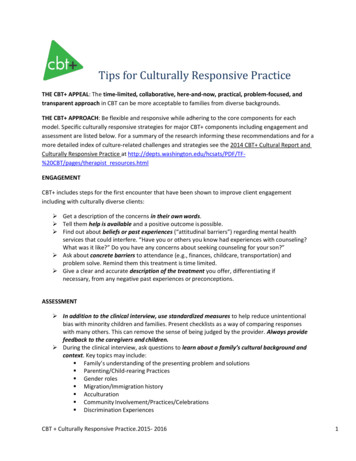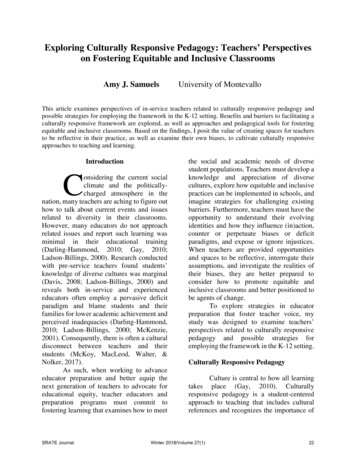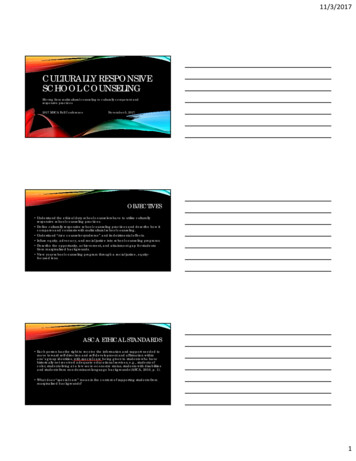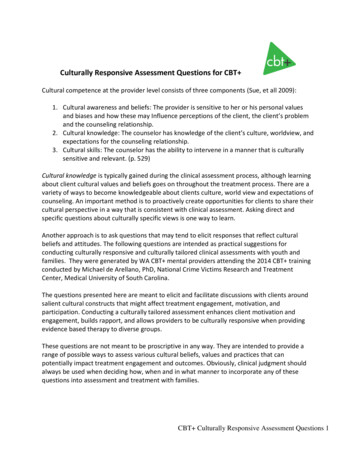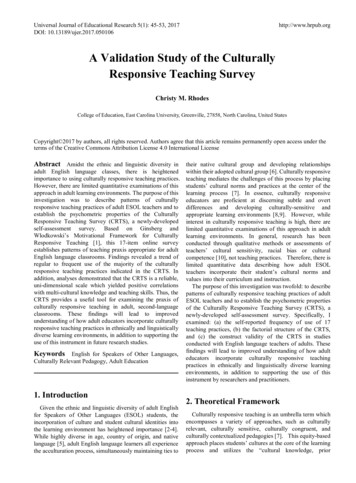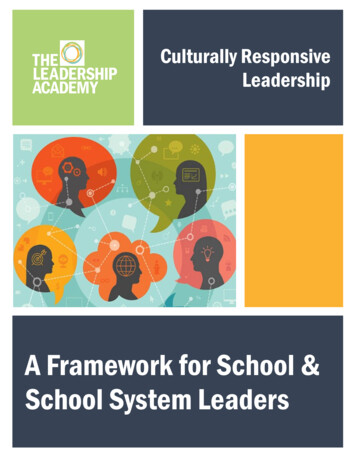
Transcription
Culturally ResponsiveLeadershipA Framework for School &School System Leaders
Culturally Responsive Leadership: A Framework for School and School System LeadersThe role of school and school system leaders is complex, challenging, and vital to the realization of an equitableand just society. Our Culturally Responsive Leadership Actions Framework is a set of leadership behaviors whichresearch and our experience in the field has shown support creating more culturally responsive learning environments for every student. Because strong systems require alignment of culture, vision, and beliefs, we have designed action frameworks for leaders at every level of the education system -- aspiring principals, school leaders,principal supervisors, and superintendents. These actions build on each other from one leadership level to thenext, clearly articulating the progression from aspiring principal to superintendent.It is well-documented that students in the United States live and learn in raciallysegregated spaces, a result of generations of racialized oppression, both codified andcultural. Segregation negatively affects the achievement, college success, long-termemployment, and income of students of color.1 Within and across segregated spaces,inequity is constantly reproduced through both action and inaction – and will continueto be reproduced and further entrenched without strong leadership to disrupt systemsof inequity and oppression.Culturally ResponsiveLeadership Actions1 LEAD FOR EQUITY & ACCESS2 ALIGN MISSION, VISION &CORE VALUESBecause inequity is so deeply embedded within educational systems, identifying anddismantling inequities must be a deeply embedded precept of leadership. Equity willnever be achieved if it is approached as a stand-alone initiative or add-on project.3 FOCUS ON INSTRUCTIONOur Culturally Responsive Leadership Actions are built from and align with nationaleducation leadership standards and integrate the specific skills, knowledge, anddispositions needed to lead for equity.5 MANAGE OPERATIONS &RESOURCESBeing culturally responsive requires continuously taking action to meet students andeducators where they are. Rather than treat our actions as prescriptive standards whichevery leader must meet in order to be deemed successful, we therefore present themas a menu of actions which leaders can use to guide their work within their uniquecontext. These actions can be used by leaders in any context: They are for leadersworking in systems and schools that serve primarily Black students, Indigenousstudents, and students of color. They are for leaders in racially and ethnically diversesystems. They are for leaders in majority white systems. Everyone in every setting has arole to play in mitigating, disrupting, and dismantling systemic oppression.Because strong systems require alignment of culture, vision, and beliefs, we havedesigned action frameworks for leaders at every level of the education system -aspiring principals, school leaders, principal supervisors, and superintendents. Theseactions build on each other from one leadership level to the next, clearly articulating theprogression from aspiring principal to superintendent.The eight actions in this document are interdependent and must start with Action 1:Lead for Equity and Access. Action 1 mirrors The Leadership Academy’s EquityLeadership Dispositions, a set of six research-based behaviors that are crucial forleaders to build a path toward creating a school community that is by, with, and forevery student. The equity-focused behaviors in Action 1 are referenced throughout theother seven actions. Within each action are several dimensions, which articulate acollection of behaviors or qualities necessary to meet the action.4 FACILITATE ADULT LEARNING& DEVELOPMENT6 ENGAGE IN PERSONALLEARNING & DEVELOPMENT7 STRATEGIZE CHANGE &CONTINUOUS IMPROVEMENT8 CULTIVATE COMMUNITY CARE& ENGAGEMENTThese actions can be used to:1 Support school systems indeveloping and integrating theirvision for equity into the day-today work of leadership2 Coach educational leaders indeveloping the skills, knowledge,and dispositions necessary forequity-focused leadership3 Develop professional learningplans for individual leaders orgroups of system leaders basedon specific needs ordevelopmental priorities1Orfieldet al, Harming our Common Future: America’s Segregated Schools 65 Years after Brown,Civil Rights Project, UCLA, May 2019. ight 2022 by The Leadership Academy. All Rights reserved.Culturally Responsive Actions 1
Culturally Responsive Leadership: A Framework for School and School System LeadersThe term minoritized is used throughout the actions to emphasize what the school systems and other systemswithin the United States have overtly and covertly done to Black, Indigenous and Students of Color. They have beentold that they are not good enough, smart enough or important enough to receive a high-quality education. We usethe term “minoritized” to recognize the need to pay particular attention to the experiences of these students in allaspects of the school system, including policies, structures, data analysis, selection of staff, curriculum, andmaterials.Culturally responsive practice is used deliberately throughout the actions and requires that education leadersunderstand and simultaneously attend to: A strong foundation of cultural understanding. Culturally responsive leaders understand the dimensions andimpact of cultural constructs in society and continuously cultivate and revisit their own personal understandingof the impact of culture on their own identity and the ways in which it shapes their approach to theirprofessional practice. The academic success of all students. Culturally responsive leaders center student learning and academic rigoracross every school, classroom, and learning environment in their system. They cultivate and value contentexpertise. They understand and apply college and career level standards and select high quality instructionalmaterials aligned to standards. They hold, model, and communicate consistently high and transparentexpectations for all learners and develop the capacity of the system and the educators within it to know whereeach student is in relation to those expectations and use that knowledge to provide appropriate learningsupports. Cultivating and deepening the cultural competence of themselves and the adults they lead. Culturallyresponsive leaders affirm the cultures of students and adults through the learning opportunities they provide,the materials they use, the environment they build, and their skill in using cultural understandings to supportlearning. They build authentic rapport and trust with students, staff, families, and the community, affirming themultiple identities of individuals, and support and guide others in doing the same. The cultivation of sociopolitical consciousness. Culturally responsive leaders cultivate and support adults’ andstudents’ ability to question and critique social norms, values, practices, and systems that produce andmaintain inequity. They facilitate adult and student talk about culture and identity and consistently look for andutilize opportunities to generate inquiry about inequity, oppression, and change.Educational leaders need strong support in order to effectively support the staff, students, families, andcommunities they serve. These actions provide a framework to help identify and provide those supports so thatleaders can sustain the necessary work of building the capacity of their schools and communities to provideequitable opportunities and achieve equitable outcomes for all students.Copyright 2022 by The Leadership Academy. All Rights reserved.Culturally Responsive Actions 2
Aspiring PrincipalActions(a revision of the Aspiring Principals Program Matrix)It is essential that aspiring principals develop theculturally responsive leadership skills needed tosupport their principal and their school community inensuring that all children and adults receive what theyeach need within an environment and system that isintentionally built for them to achieve academic, socialand emotional success regardless of race, ethnicity,language or other characteristics of their identity. Forthe aspiring principal, we provide leveled actions tohelp guide their development and provide aspiringprincipal mentors and development programs a tool forassessing the aspiring leader’s growth.Copyright 2022 by The Leadership Academy. All Rights reserved.Culturally Responsive Actions 3
ACTION 1: LEAD FOR EQUITY & ACCESSCulturally responsive aspiring school leaders learn andpractice equitable, liberatory skills and dispositions tocontribute to the creation of a school community by, with, andfor students.The equity-focused behaviors in Action 1 are referenced throughout each of the other seven actions.DIMENSIONCHARACTERISTICS/QUALITIES Identifies and continuously examines assumptions, beliefs, and personal biases, a. Reflects on personalbeliefs, biases,assumptions, andbehaviors especially those associated with those who have been historically minoritized dueto their race, ethnicity, gender, sexual orientation and socio-economic status, etc.Acknowledges the effect of personal mental models on actions that impactstudent learning and achievementContinuously examines and reflects on how their role in the system maycontribute to or support inequitable practicesActively seeks to learn how privilege, power, and oppression operate historicallyand currently to create and sustain inequityRecognizes inherent personal privileges based on position, identity, andbackground, especially those associated with those who have been historicallyminoritizedIdentifies and acts on personal knowledge gaps and skills deficits related toequity Models vulnerability by acknowledging former and current personal knowledgeb. Publicly models apersonal belief systemthat is student-centeredand grounded in equityand accessc. Acts with culturalcompetence andresponsiveness ininteractions, data-drivendecision-making, andpracticegaps and skills deficits related to equity, including what they did or plan to do toclose them Learns and practices language and behaviors that are responsive to differencesacross lines of race, ethnicity, language, class, religion, ability, gender identity andexpression, sexual orientation, and other aspects of identity Utilizes data that has been disaggregated by minoritized populations tounderstand the specific needs of the school community Models strategies designed to support adults and students to engage in contextspecific, culturally responsive learning about difference Partners with families, staff, and communities to ensure fair treatment andequitable access to academic, social and emotional opportunities Actively seeks and makes use of diverse perspectives in decision-making Pays close attention to voices that are absent from conversations and activelyseeks them to gain their perspective Evaluates the intended and unintended consequences of decisions on allstakeholder groupsCopyright 2022 by The Leadership Academy. All Rights reserved.Culturally Responsive Actions 4
ACTION 1: LEAD FOR EQUITY & ACCESS (cont’d)DIMENSIONc. Acts with culturalcompetence andresponsiveness ininteractions, data-drivendecision-making, andpractice (con’t)CHARACTERISTICS/QUALITIES Encourages risk-taking and create spaces to engage in dialogue about race andaddress hard-to-discuss topics Prioritizes and models culturally responsive practice as a foundational element ofprofessional practice Navigates political contexts internal and external to the school that influenceequitable practice and access Initiates and promotes productive dialogue and collective work on issues ofinequity for all minoritized populations Creates the conditions and common language for regular courageousconversations around equityd. Purposefully builds thecapacity of others toidentify and disruptinequities in the school Builds colleagues’ capacity to learn and practice language and behaviors that areresponsive to differences across lines of race, ethnicity, language, class, religion,ability, gender identity and expression, sexual orientation, and other aspects ofidentity Supports the school leader in providing the space, tools, and support for staff toreflect on their own personal beliefs, biases, assumptions, and behavior,especially those who have been historically minoritized Supports the school leader in providing structured and consistent professionallearning opportunities to develop and deepen culturally responsive teachingpractice Confronts behavior that openly or covertly promotes or sustains inequity,e. Confronts and altersinstitutional biases ofstudent marginalization,deficit-based schooling,and low expectationsassociated withminoritized populationscolorblindness, and deficit-thinking Identifies and names practices and interactions, including micro-aggressions, thatare based on race or culturally-biased assumptions Works with colleagues to ensure that communication, collaboration, and decision-making reflect the system’s mission, vision, and values grounded in equity andaccess for all students Regularly examines school disaggregated data with teachers and staff forevidence of inequity Investigates existing policies and practices to ensure they prioritize student needsand are designed to produce equitable outcomes Supports the school leader to ensure that equity is at the forefront of the schoolf. Creates equitablesystems and structures topromote equity with afocus on minoritizedpopulationsmission, vision, and values Co-creates and implements practices that promote the support and retention ofdiverse and culturally responsive staff Supports the school leader in seeking, allocating, and managing resources todirectly support groups that have been historically minoritized Establishes routines and systems that foster a sense of belonging among allstudents Supports the school leader in creating structures to ensure the long-termsustainability of initiatives that promote equityCopyright 2022 by The Leadership Academy. All Rights reserved.Culturally Responsive Actions 5
ACTION 2: ALIGN MISSION, VISION & VALUESCulturally responsive aspiring school leaders work with theprincipal, colleagues, and community to develop, advocate,and act according to a shared school mission, vision, and corevalues for culturally responsive teaching and learning thatsupports all students in accessing and achieving rigorouscollege- and career-ready academic standards.The equity-focused behaviors in Action 1 are referenced throughout each of the other seven actions.Those equity-focused behaviors that are integral to Action 2 and align with Action 1 are italicized below.DIMENSION: a. Collaboratively develops system mission, vision, and values aligned to promote success for all studentsCHARACTERISTICS/QUALITIES THATDEMONSTRATE PROGRESS TOWARD THESTANDARDCHARACTERISTICS/QUALITIES THATMEET THE STANDARD Collaborates with families, students, staff, and othermembers of the schoolcommunity to develop a sharedmission, vision, and values thatarticulate the conditions andactions to which the schoolaspires in order to ensureequitable access to, andachievement of, rigorous collegeand career-ready academicstandards for all students (1.c)Initiates and facilitatescourageous conversations aboutequity of student opportunity andoutcomes related to the schoolmission, vision, and values (1.c)Initiates and facilitatescourageous conversations aboutinclusion and belonging within theschool’s mission, vision, andvalues (1.c)Clearly articulates the mission,vision, and values to all membersof the school communityCultivates shared understandingand ownership of the mission,vision, and values among allmembers of the school communityCopyright 2022 by The Leadership Academy. All Rights reserved. Collaborates with some stakeholders in the development and/or revisionof the school’s mission, vision, andvaluesOccasionally initiates and facilitatescourageous conversations aboutequity of student opportunity andoutcomes related to the schoolmission, vision, and valuesOccasionally initiates and facilitatescourageous conversations aboutinclusion and belonging within theschool’s mission, vision, and valuesClearly articulates the mission,vision, and values to some membersof the school communityIs working to generate sharedunderstanding and ownership of themission, vision, and values amongmembers of the school communityCHARACTERISTICS/QUALITIES THATDO NOT MEET THE STANDARD Does not collaborate with families, students, staff, andother members of the schoolcommunity in the developmentand/or revision of the school’smission, vision, and valuesDoes not initiate conversationsabout equity of studentopportunity and outcomesDoes not initiate conversationsabout inclusion and belongingIs unable to clearly articulatethe school’s mission, vision,and valuesDoes not work to generateshared understanding andownership of the mission,vision, and values amongmembers of the schoolcommunityCulturally Responsive Actions 6
ACTION 2: ALIGN MISSION, VISION & VALUES (cont’d)DIMENSION: b. Uses the school’s mission, vision, and values to guide decision-making, continuous improvement, andstrategic planningCHARACTERISTICS/QUALITIES THATMEET THE STANDARDCHARACTERISTICS/QUALITIES THATDEMONSTRATE PROGRESS TOWARD THESTANDARDCHARACTERISTICS/QUALITIES THATDO NOT MEET THE STANDARD Communicates, collaborates, and Usually communicates, collaborates, Rarely or never communicates,makes decisions in ways thatreflect the organization’s valuesand belief in equity and access forall students (1.c) Anchors all planning processes,including cycles of continuousimprovement, grant projects, anddistrict, state, and federalprogram planning, to the school’smission, vision, and values Consistently evaluates decisionsfor effectiveness in advancing theschool’s mission, vision, andvaluesand makes decisions in ways thatreflect the organization’s values andbelief in equity and access for allstudents Anchors some planning processes tothe school’s mission, vision, andvalues Usually evaluates decisions foreffectiveness in advancing theschool’s mission, vision, and valuescollaborates, and/or makesdecisions in ways that reflectthe organization’s values andbelief in equity and access forall students Engages in and/or leadsplanning processes withoutaligning them to the mission,vision, and values of theschool Does not evaluate decisionsfor effectiveness in advancingthe school’s mission, vision,and valuesCopyright 2022 by The Leadership Academy. All Rights reserved.Culturally Responsive Actions 7
ACTION 3: FOCUS ON INSTRUCTIONCulturally responsive aspiring school leaders contribute to thedevelopment and support of systems, structures, and routinesthat prioritize and focus the alignment and coherence ofculturally responsive curriculum, high-quality instructionalmaterials, instructional practice, and assessment to supportall students in accessing and achieving rigorous college- andcareer-ready academic standards.The equity-focused behaviors in Action 1 are referenced throughout each of the other seven actions.Those equity-focused behaviors that are integral to Action 2 and align with Action 1 are italicized below.DIMENSION: a. Engages in own ongoing development in culturally responsive instructional practice and leadership toCHARACTERISTICS/QUALITIES THATMEET THE STANDARD Maintains expertise and stays up to date with local, state, andnational initiatives related to theinstructional core and culturallyresponsive practice (1.c)Consistently keeps abreast of anduses research and theories oflearning and change to informinstructional and organizationaldecisionsUtilizes a research—basedfoundation to support, plan, andguide own personal culturallyresponsive instructionalleadership practice (1.c)Communicates an explicit planoutlining their role in supportingteachers to achieve their culturallyresponsive instructional goals(1.c)Seeks out and engages incoaching to support own reflectivepractice and continuousimprovement in culturallyresponsive instructionalleadership (1.c)Copyright 2022 by The Leadership Academy. All Rights reserved.CHARACTERISTICS/QUALITIES THATDEMONSTRATE PROGRESS TOWARD THESTANDARDCHARACTERISTICS/QUALITIES THATDO NOT MEET THE STANDARD Working towards an understanding of Is not aware of, or does notlocal, state, and national initiativesrelated to the instructional core andculturally responsive practice Demonstrates occasional use ofresearch and theories of learningand change to inform instructionaland organizational decisions Develops incomplete or unclearplans for supporting teachers toachieve their culturally responsiveinstructional goals Occasionally seeks out coaching orother types of professional learningto improve culturally responsiveinstructional leadershipunderstand, local, state, andnational initiatives related tothe instructional core andculturally responsive practice Does not understand or useresearch or theories oflearning and change to informinstructional or organizationaldecisions Does not develop plans tosupport teachers to achievetheir culturally responsiveinstructional goals Does not engage in coachingand other types of professionallearning to improve culturallyresponsive instructionalleadershipCulturally Responsive Actions 8
ACTION 3: FOCUS ON INSTRUCTION (cont’d)DIMENSION: b. Demonstrates understanding of the relationship between standards, curriculum, and assessmentCHARACTERISTICS/QUALITIES THATMEET THE STANDARDCHARACTERISTICS/QUALITIES THATDEMONSTRATE PROGRESS TOWARD THESTANDARD Maintains working knowledge of Developing a working knowledge of Has little to no knowledge ofcurrent college- and career-readystandards Understands the analysis andalignment of standards, curriculum,and assessment tools but does notengage staff in discussions aroundcoherence and alignment withcurrent curriculum Occasionally or randomly reviews andassesses curriculum, assessments,learning materials, and instructionalpractice for evidence of culturalresponsivenesscurrent college- and careerready standards Does not understand therelationship betweenstandards, curriculum, andassessment and is unable toarticulate the importance ofalignment Does not review and assesscurriculum, assessments,learning materials, andinstructional practice forevidence of culturalresponsiveness current college- and career-readystandards as written and inpracticeEngages instructional staff inensuring coherence andalignment among college- andcareer-ready standards and thecurriculumEnsures high-quality instructionalcurriculum and materials areprovided, adopted and supportedUnderstands the role of alignedassessment tools to supportstandards and curriculumRegularly and systematicallyreviews and assesses curriculum,assessments, learning materials,and instructional practice toensure all students have accessto consistently culturallyresponsive learning environmentsand experiencesCopyright 2022 by The Leadership Academy. All Rights reserved.CHARACTERISTICS/QUALITIES THATDO NOT MEET THE STANDARDCulturally Responsive Actions 9
ACTION 3: FOCUS ON INSTRUCTION (cont’d)DIMENSION: c. Supports systems of shared leadership that enable college- and career-ready academic expectations tobe met by all studentsCHARACTERISTICS/QUALITIES THATMEET THE STANDARDCHARACTERISTICS/QUALITIES THATDEMONSTRATE PROGRESS TOWARD THESTANDARDCHARACTERISTICS/QUALITIES THATDO NOT MEET THE STANDARD Supports an instructional Is building an instructional leadership Does not attend to theleadership team representative ofthe student population, gradelevels, academic content, andstudent support services providedin the school Provides opportunities for staff tolearn, use, and share specializedknowledge and skills for thepurpose of improving school-wideculturally responsive instructionalpractice Provides formal and informalleadership opportunities forteacher leaders and other teammembers and encourages them toexercise appropriate authority inthose areas for which they areheld accountable Routinely identifies and providesopportunities to mentor, coach,and develop emerging leadersfrom diverse backgroundsteam representative of the gradelevels, academic content, andstudent support services provided inthe school Sometimes provides opportunitiesfor staff to learn, use, and sharespecialized knowledge and skills forthe purpose of improving school-wideculturally responsive instructionalpractice Occasionally provides formal andinformal leadership opportunities forteacher leaders and other teammembers and encourages them toexercise appropriate authority inthose areas for which they are heldaccountable Occasionally identifies and providesopportunities to mentor, coach, anddevelop emerging leaders fromdiverse backgroundscultivation of a representativeinstructional leadership team Does not provide opportunitiesfor staff to learn, use, andshare specialized knowledgeand skills for the purpose ofimproving school-wideculturally responsiveinstructional practice Does not provide formal andinformal leadershipopportunities for others Does not identify or provideopportunities to mentor,coach, and develop emergingleaders from diversebackgroundsCopyright 2022 by The Leadership Academy. All Rights reserved.Culturally Responsive Actions 10
ACTION 3: FOCUS ON INSTRUCTION (cont’d)DIMENSION: d. Uses student access, opportunity, and outcomes data to engage in culturally responsive instructionalleadership decisionsCHARACTERISTICS/QUALITIES THATDEMONSTRATE PROGRESS TOWARD THESTANDARDCHARACTERISTICS/QUALITIES THATMEET THE STANDARD Ensures consistency in high- quality Tier 1 instruction aligned torigorous college- and career-readyacademic standardsDevelops and implementsconsistent and equitableprocesses for providing andmonitoring Tier 2 and Tier 3interventions to strugglinglearners to scaffold and supportuniversal access to Tier 1instruction (1.e)Supports teachers in selectingstudent data that will provide acomprehensive profile of howstudents learnSupport teachers in usingdisaggregated data to setindividualized learning goals thatmove students into the zone ofproductive disequilibrium andsupport all students in becomingindependent learners (1.f)Collects and uses data on thelearning environment (studentgrouping, visible instructionalmaterials, etc.) to make culturallyresponsive instructionalleadership decisions (1.c)Establishes formal and informalstructures for engaging withstudents to elicit their feedbackon the learning environmentCopyright 2022 by The Leadership Academy. All Rights reserved. Working to support consistency in high-quality Tier 1 instruction alignedto rigorous college- and career-readyacademic standardsWorking to develop and implementconsistent and equitable processesfor providing and monitoring Tier 2and Tier 3 interventionsSometimes supports teachers inusing data to set individualizedlearning goals that move studentsinto the zone of productivedisequilibriumSometimes collects and/or uses dataon the learning environment to makeculturally responsive instructionalleadership decisionsEngages with students informally toelicit their feedback on the learningenvironmentCHARACTERISTICS/QUALITIES THATDO NOT MEET THE STANDARD Does not attend to the need for consistent high-quality Tier1 instructionDoes not attend to the needfor consistency or equity inproviding and monitoringinstructional interventionsDoes not support teachers inusing data to set individualizedlearning goals that movestudents into the zone ofproductive disequilibriumDoes not collect and/or usedata on the learningenvironment to make culturallyresponsive instructionalleadership decisionsDoes not engage with studentsformally or informally to elicittheir feedback on the learningenvironmentCulturally Responsive Actions 11
ACTION 3: FOCUS ON INSTRUCTION (cont’d)DIMENSION: e. Uses student access, opportunity, and outcomes data to engage in culturally responsive instructionalleadership decisionsCHARACTERISTICS/QUALITIES THATMEET THE STANDARDCHARACTERISTICS/QUALITIES THATDEMONSTRATE PROGRESS TOWARD THESTANDARDCHARACTERISTICS/QUALITIES THATDO NOT MEET THE STANDARD Holds and communicates an Holds and sometimes communicates Communicates disbelief thatunwavering belief system that allstudents, regardless of past orcurrent performance, can meetrigorous, college- and career-readyacademic standards (1.b) Gathers and uses multipleindicators of student learning thatreveal patterns, trends, andinsights about equitable accessand outcomes (1.c) Disaggregates data by studentsubgroups to identify disparitiesby race, ethnicity, language, andother characteristics (1.d) Creates tools, processes, and/orsystems to ensure that data areaccessible to, and understood by,all staff, students, families, andother members of the schoolcommunityan unwavering belief system that allstudents, regardless of past orcurrent performance, can meetrigorous, college- and career-readyacademic standards Gathers multiple indicators ofstudent learning that reveal patterns,trends, and insights about equitablepractice and outcomes Sometimes disaggregates data bystudent subgroups to identifydisparities by race, ethnicity,language, and other characteristics Developing the ability to create tools,processes, and/or systems to ensurethat data are accessible to, andunderstood by, all staff, students,families, and other members of theschool communityall students, regardless of pastor current performance, canmeet rigorous, college- andcareer-ready academicstandards through the use ofvictim-blaming or otherstrategies Looks at single data points orirrelevant, unaligned datapoints as
as a menu of actions which leaders can use to guide their work within their unique context. These actions can be used by leaders in any context: They are for leaders working in systems and schools that serve primarily Black students, Indigenous students, and students of color. They are for leaders in racially and ethnically diverse systems.




